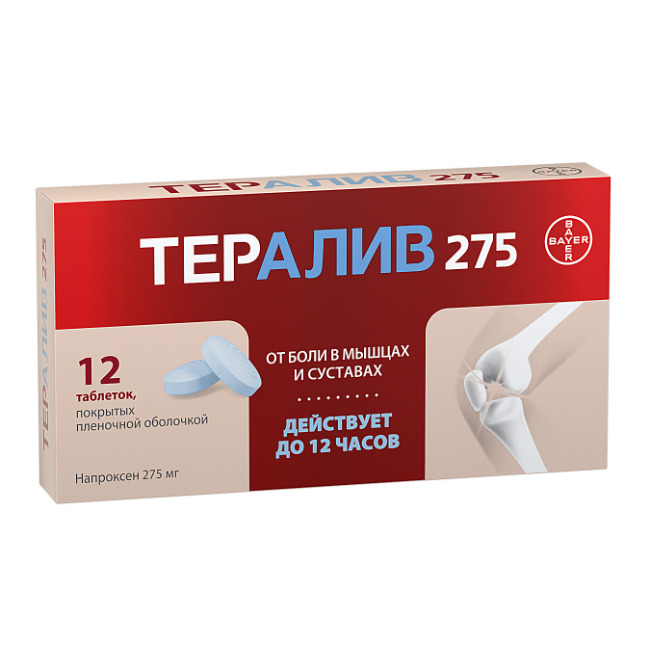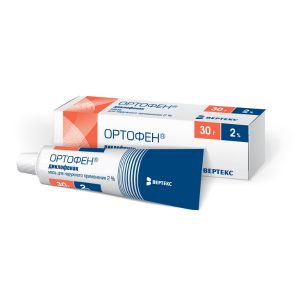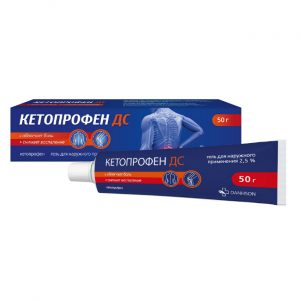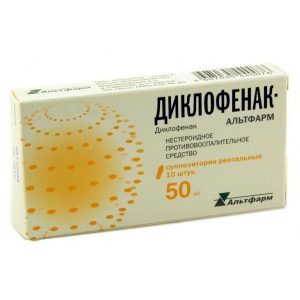Description
Pharmacological action
The drug Theraliv 275 is an anesthetic and analgesic, it has anti-inflammatory effects. The mechanism of action is associated with non-selective inhibition of the activity of cyclooxygenase-1 and -2 (COX-1, COX-2).
Theraliv 275, film-coated tablets dissolves well, is rapidly absorbed from the gastrointestinal tract and provides a rapid onset of analgesic effect.
Pharmacokinetics
Absorption
Quickly and completely absorbed from the digestive tract. Bioavailability – 95% (food intake practically does not affect either completeness or absorption rate). The time to reach Cmax in blood plasma is 1-2 hours.
Distribution of
Plasma protein binding> 99%. T1 / 2 – 12-15 hours. Metabolism occurs in the liver to dimethylnaproxen with the participation of the
SUR2C9 isoenzyme.
Excretion
Clearance – 0.13 ml / min / kg. It is excreted by 98% by the kidneys, 10% is excreted unchanged, with bile – 0.5-2.5%. Css in blood plasma is determined after taking 4-5 doses of the drug (2-3 days).
With renal failure, cumulation of metabolites is possible.
Indications
Diseases of the musculoskeletal system:
rheumatic soft tissue lesions
osteoarthritis of the peripheral joints and spine, incl. with radicular syndrome
tenosynovitis
bursitis.
Mild to moderate pain syndrome:
neuralgia
ossalgia
myalgia
lumbar ischialgia
post-traumatic pain syndrome (sprains and bruises), accompanied by inflammation
headache, migraine srdlp
As part of the complex treatment of infectious and inflammatory diseases of the ear, throat, nose with severe pain:
pharyngitis
tonsillitis
otitis media.
Feverish syndrome with colds and infectious diseases.
Theraliv 275 is used for symptomatic therapy (to reduce pain, inflammation and lower fever) and does not affect the progression of the underlying disease.
Contraindications
Hypersensitivity to naproxen or naproxen sodium
complete or incomplete combination of bronchial asthma, recurrent polyposis of the nose or paranasal sinuses and intolerance to acetylsalicylic acid and other NSAIDs (including history)
period after coronary artery bypass grafting
erosive and ulcerative changes in the gastric or duodenal mucosa
active gastrointestinal bleeding
inflammatory bowel disease (non-specific ulcerative colitis, hemorrhagic exacerbation and other acute hemorrhage disease)
cerebrovascular bleeding or other bleeding
decompensated heart failure.
severe liver failure or active liver disease
severe renal failure (CC less than 30 ml / min), progressive kidney disease
confirmed hyperkalemia
pregnancy
breastfeeding
children under 15 years of age.
Caution
ischemic heart disease, cerebrovascular disease, congestive heart failure, dyslipidemia / hyperlipidemia, diabetes mellitus, peripheral arterial disease, smoking, impaired renal function (CC 30-60 ml / min), history of gastrointestinal ulcer, presence of Helicobacter pylori infection, use in elderly patients age, systemic lupus erythematosus or mixed connective tissue diseases (Sharpe syndrome), prolonged use of NSAIDs, frequent alcohol consumption, severe somatic diseases, concomitant therapy as follows and drugs: anticoagulants (e.g. warfarin), antiplatelet agents (e.g. acetylsalicylic acid, clopidogrel), oral glucocorticoids (e.g. prednisone), selective serotonin reuptake inhibitors (e.g. citalopram, fluoxetine, paroxetine, sertraline).
Special instructions
Do not exceed the doses indicated in the instructions. To reduce the risk of adverse events from the gastrointestinal tract, the minimum effective dose should be used with the minimum possible short course.
If pain and fever persist or get worse, you should consult a doctor.
Patients with bronchial asthma, with bleeding disorders, as well as patients with hypersensitivity to other analgesics, should be consulted with a doctor before taking Teraliv 275.
Caution should be given to patients with liver disease and renal failure.
In chronic alcoholic and other forms of liver cirrhosis, the concentration of unbound naproxen increases, therefore, lower doses are recommended for such patients. After two weeks of using the drug, monitoring of liver function indicators is necessary.
In patients with renal failure, QC should be monitored. With CC less than 30 ml / min, naproxen is not recommended.
Theraliv 275 should not be taken together with other anti-inflammatory and painkillers, except for doctor’s prescriptions.
Older patients are also recommended lower doses.
Naproxen should be avoided for 48 hours prior to surgery.
If it is necessary to determine 17-corticosteroids, the drug should be discontinued 48 hours before the study. Similarly, naproxen may affect the determination of 5-hydroxyindoleacetic acid in urine.
Each tablet of Teraliv 275 contains approximately 25 mg of sodium. When limiting salt intake, this must be taken into account.
Influence on the ability to drive vehicles and mechanisms
Naproxen slows down the reaction rate in patients. This should be considered when driving and performing tasks that require increased attention.
Composition
1 tab.
naproxen sodium 275 mg
Excipients:
microcrystalline cellulose – 55 mg,
povidone K30 – 12.5 mg,
talcum powder – 15.75 mg,
magnesium stearate – 2.63 mg
film coat:
opadray blue YS-1-4215 – 9 mg: srdlg ind, poppy
titanium dioxide,
hypromellose.
Side effects
Adverse effects that may develop during treatment with naproxen are classified according to the following frequency of occurrence: very often (> 1/10), often (from 1/100 to <1/10), infrequently (from 1/1000 to <1/100), rarely (from 1/10000 to <1/1000), very rarely (<1/10000), the frequency is unknown (cannot be determined based on available data). In each group, adverse events are listed in decreasing order of severity. From the gastrointestinal tract: the most frequently observed adverse events from the gastrointestinal tract. Perhaps the development of peptic ulcers, perforation or gastrointestinal bleeding, sometimes fatal, especially in elderly patients (see section Special instructions). From the blood and lymphatic system: infrequently – eosinophilia, granulocytopenia, leukopenia, thrombocytopenia. From the nervous system: often – headache, vertigo, dizziness, drowsiness infrequently – depression, sleep disturbances, inability to concentrate, insomnia, malaise. From the side of the organ of vision: often – visual impairment. On the part of the hearing organ and labyrinth disorders: often – tinnitus, hearing impairment infrequently – hearing loss. From the side of the heart: often – swelling, palpitations infrequently – congestive heart failure. From the respiratory system, chest and mediastinal organs: often – shortness of breath infrequently – eosinophilic pneumonia. From the gastrointestinal tract: often – constipation, abdominal pain, dyspepsia, nausea, diarrhea, stomatitis, flatulence infrequently – gastrointestinal bleeding and / or perforation of the stomach, bloody vomiting, melena, vomiting very rarely – relapse or exacerbation of ulcerative colitis or disease Crohn’s frequency is unknown – gastritis. From the liver and biliary tract: infrequently – increased activity of liver enzymes, jaundice. From the skin and subcutaneous tissues: often – itchy skin, rash, ecchymosis, purpura infrequently – alopecia, photodermatosis very rarely – bullous reactions, including Stevens-Johnson syndrome and toxic epidermal necrolysis. From the side of the musculoskeletal system and connective tissue: infrequently – myalgia and muscle weakness. From the side of the kidneys and urinary tract: infrequently – glomerulonephritis, hematuria, interstitial nephritis, nephrotic syndrome, renal failure, renal papillary necrosis. General disorders: often – thirst, sweating infrequently – hypersensitivity reactions, menstrual irregularities, hyperthermia (chills and fever). In the treatment of NSAIDs, the appearance of edema and symptoms of heart failure, increased blood pressure have been reported. Clinical studies and epidemiological data suggest that the use of certain NSAIDs (especially high doses and with long-term therapy) may be associated with a slight increase in the risk of arterial thrombosis (for example, myocardial infarction or stroke). Undesirable effects, a causal relationship with naproxen has not been established From the blood and lymphatic systems: aplastic anemia, hemolytic anemia. From the nervous system: aseptic meningitis, cognitive dysfunction. From the skin and subcutaneous tissues: erythema multiforme, photosensitivity reactions similar to late cutaneous porphyria and epidermolysis bullosa, urticaria. From the vessels: vasculitis. Common disorders: angioedema, hyperglycemia, hypoglycemia. If the patient has noticed such phenomena, then you should stop taking the drug and, if possible, consult a doctor. Overdose Symptoms: A significant overdose of naproxen can be characterized by drowsiness, dyspeptic disorders (heartburn, nausea, vomiting, abdominal pain), weakness, tinnitus, irritability, and in severe cases – bloody vomiting, cramping, and cramping, failure. Treatment: A patient who accidentally or intentionally takes a large amount of Teraliv 275 needs to rinse the stomach, take activated charcoal and carry out symptomatic therapy: antacids, histamine H2 receptor blockers, proton pump inhibitors. Hemodialysis is ineffective. Storage conditions The drug should be stored out of the reach of children at a temperature not exceeding 25 ° C. Expiration 5 years. Deystvuyuschee substances Naproxen Conditions of release from pharmacies Without a prescription dosage form tablets




